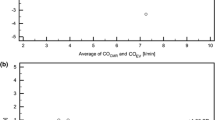Abstract
The purpose of this stuy is to prospectively assess the reliability of the ultrasound cardiac output monitor (USCOM™) for measuring stroke volume index and predicting left ventricular outflow tract diameter in adolescents with heart disease. Sixty consecutive adolescents with heart disease attending a tertiary medical center underwent USCOM™ assessment immediately after cardiac magnetic resonance imaging. USCOM™ measured stroke volume index and predicted left ventricular outflow tract diameter were compared to cardiac magnetic resonance imaging-derived values using Bland–Altman analysis. Ten patients with an abnormal left ventricular outflow tract were excluded from the analysis. An adequate USCOM™ signal was obtained in 49/50 patients. Mean stroke volume index was 46.1 ml/m2 by the USCOM™ (range 22–66.9 ml/m2) and 42.9 ml/m2 by cardiac magnetic resonance imaging (range 24.7–59.9 ml/m2). The bias (mean difference) was 3.2 ml/m2; precision (± 2SD of differences), 17 ml/m2; and mean percentage error, 38%. The mean (± 2SD) left ventricular outflow tract diameter was 0.445 ± 0.536 cm smaller by the USCOM™ algorithm prediction than by cardiac magnetic resonance imaging. Attempted adjustment of USCOM™ stroke volume index using cardiac magnetic resonance imaging left ventricular outflow tract diameter failed to improve agreement between the two modalities (bias 28.4 ml/m2, precision 44.1 ml/m2, percentage error 77.3%). Our study raises concerns regarding the reliability of USCOM™ for stroke volume index measurement in adolescents with cardiac disease, which did not improve even after adjusting for its inaccurate left ventricular outflow tract diameter prediction.








Similar content being viewed by others
References
Davis AL, Carcillo JA, Aneja RK et al (2017) The American College of Critical Care Medicine Clinical Practice Parameters for Hemodynamic Support of paediatric and neonatal septic shock. Pediatr Crit Care Med 45:1061–1093. https://doi.org/10.1097/CCM.0000000000002425
FDA US Food & Drug Administration, https://www.accessdata.fda.gov/scripts/cdrh/cfdocs/cfpmn/pmn.cfm?ID=K043139; 2019 [accessed October 2019]
Critchley LA, Peng ZY, Fok BS, Lee A, Phillips RA (2005) Testing the reliability of a new ultrasonic cardiac output monitor, the USCOM, by using aortic flowprobes in anesthetized dogs. Anesth Analg 100:748–753. https://doi.org/10.1213/01.ANE.0000144774.42408.05
Chan JS, Segara D, Nair P (2005) Measurement of cardiac output with a noninvasive continuous wave Doppler device versus the pulmonary artery catheter: a comparative study. Crit Care Resusc 8:309–314
Chand R, Mehta Y, Terhan N (2006) Cardiac output estimation with a new Doppler device after off-pump coronary artery bypass surgery. J Cardiothorac Vasc Anesth 20:315–319. https://doi.org/10.1053/j.jvca.2005.05.024
Knobloch K, Lichtenberg A, Winterhalter M, Rossner D, Pichlmaier M, Phillips R (2005) Non-invasive cardiac output determination by two dimensional independent Doppler during and after cardiac surgery. Ann Thorac Surg 80:1479–1483. https://doi.org/10.1016/j.athoracsur.2004.12.034
Tan HL, Pinder M, Parsons R, Roberts B, van Heerden PV (2005) Clinical evaluation of USCOM ultrasonic cardiac output monitor in cardiac surgical patients in intensive care unit. Br J Anaesth 94:287–291. https://doi.org/10.1093/bja/aei054
Knirsch W, Kretschmar O, Tomaske M, Stutz K, Nagdyman N, Balmer C et al (2008) Cardiac output measurement in children: comparison of the ultrasound cardiac output monitor with thermodilution cardiac output measurement. Intensive Care Med 34:1060–1064. https://doi.org/10.1007/s00134-008-1030-y
Nguyen HB, Banta DP, Stewart G, Kim T, Bansal R, Anholm J et al (2010) Cardiac index measurement by transcutaneous Doppler ultrasound and transthoracic echocardiography in adult and paediatric emergency patients. J Clin Monit Comput 24:237–247. https://doi.org/10.1007/s10877-010-9240-6
Beltramo F, Menteer J, Razavi A, Khemani RG, Szmuszkovicz J, Newth CJ et al (2016) Validation of an ultrasound cardiac output monitor as a bedside tool for paediatric patients. Pediatr Cardiol 37:177–183. https://doi.org/10.1007/s00246-015-1261-y
Dhanani S, Barrowman NJ, Ward RE, Murto KT (2011) Intra- and inter- observer reliability using a noninvasive ultrasound cardiac output monitor in healthy anesthetized children. Paediatr Anaesth 21:858–864. https://doi.org/10.1111/j.1460-9592.2010.03480.x
Pohost GM, Hung L, Doyle M (2003) Clinical use of cardiovascular magnetic resonance. Circulation 108:647–653. https://doi.org/10.1161/01.CIR.0000083233.86078.3E
Pennell D (2001) Cardiovascular magnetic resonance. Heart 85:581–589. https://doi.org/10.1136/heart.85.5.581
Trinkmann F, Doesch C, Papavassiliu T, Weissmann J, haghi D, Gruettner J, et al (2010) A novel noninvasive ultrasonic cardiac output monitor: comparison with cardiac magnetic resonance. Clin Cardiol 33:E8-14. https://doi.org/10.1002/clc.20612
Nidorf SM, Picard MH, Triulzi MO, Thomas JD, Newell J, King ME et al (1992) New perspectives in the assessment of cardiac chamber dimensions during development and adulthood. J Am Coll Cardiol 19:983–988. https://doi.org/10.1016/0735-1097(92)90282-r
Chin CW, Khaw HJ, Luo E, Tan S, White AC, Newby DE et al (2014) Echocardiography underestimates stroke volume and aortic valve area: implications for patients with small-area low-gradient aortic stenosis. Can J Cardiol 30:1064–1072. https://doi.org/10.1016/j.cjca.2014.04.021
Bland JM, Altman DG (1986) Statistical methods for assessing agreement between two methods of clinical measurement. Lancet 1:307–310
Critchley LA, Critchley JA (1999) A meta-analysis of studies using bias and precision statistics to compare cardiac output measurement techniques. J Clin Monit Comput 15:85–91
Funding
This research did not receive any specific grant from funding agencies in the public, commercial, or not-for-profit sectors.
Author information
Authors and Affiliations
Contributions
Weissbach conceptualized and designed the study, coordinated and supervised data collection, carried out the USCOM™ measurements, drafted the initial manuscript, carried out the statistical analyses, and reviewed and revised the manuscript. Rotstein, Lakovsky, and Birk took significant part in study design, CMRI measurements, data collection, and reviewed and critically revised the manuscript. Kadmon and Kaplan contributed to the study design, data collection, data analysis, and critical revision of the manuscript. Nahum conceptualized and contributed to study design, data analysis, and reviewed the manuscript. All authors approved the final manuscript as submitted and agreed to be accountable for all aspects of the work.
Corresponding author
Ethics declarations
Conflict of interest
The authors declare that they have no conflict of interest.
Additional information
Publisher's Note
Springer Nature remains neutral with regard to jurisdictional claims in published maps and institutional affiliations.
Rights and permissions
About this article
Cite this article
Weissbach, A., Rotstein, A., Lakovsky, Y. et al. Ultrasound Cardiac Output Monitor (USCOM™) Measurements Prove Unreliable Compared to Cardiac Magnetic Resonance Imaging in Adolescents with Cardiac Disease. Pediatr Cardiol 42, 692–699 (2021). https://doi.org/10.1007/s00246-020-02531-8
Received:
Accepted:
Published:
Issue Date:
DOI: https://doi.org/10.1007/s00246-020-02531-8




